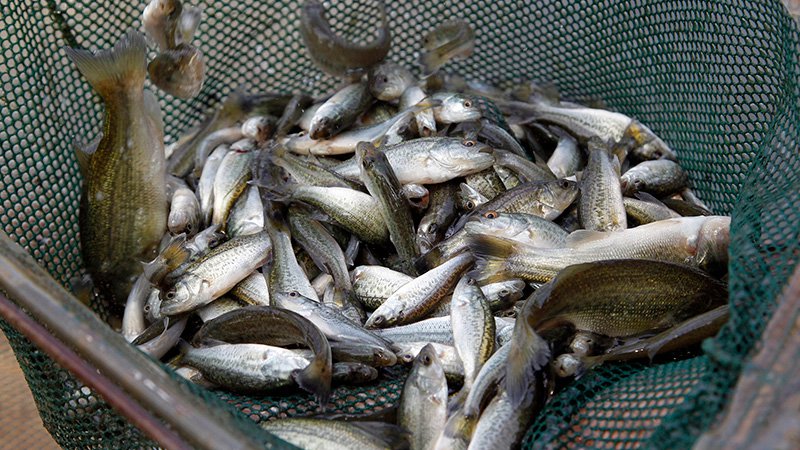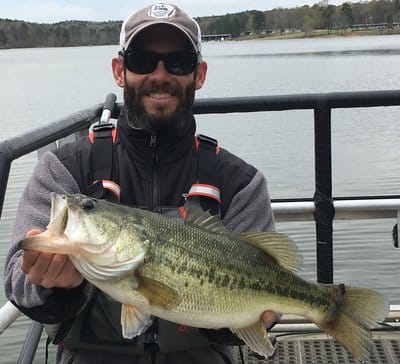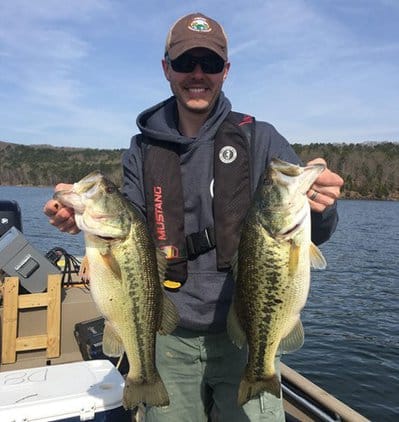AGFC biologists win awards for Florida bass research in Hot Springs area lakes
ON 03-23-2022

March 23, 2022
Randy Zellers
Assistant Chief of Communications
HOT SPRINGS — In the world of bass fishing, all eyes are on Florida, well at least Florida largemouth bass. Biologists from Arkansas, however, claimed this year’s Jack Dequine Award for Fisheries Outstanding Technical Paper for work about how these Sunshine State fish have fared in two Natural State reservoirs.
Sean Lusk and Chris Middaugh, biologists with the Arkansas Game and Fish Commission, recently received top honors from the Southern Division of the American Fisheries Society for outstanding technical papers at the most recent conference of the Southeastern Association of Fish and Wildlife Agencies. Both of these papers revolved around the introduction of Florida largemouth bass in DeGray Lake and Lake Ouachita.
The top paper belonged to Lusk, who was assistant fisheries supervisor for the Hot Springs area until a recent promotion to the Little Rock office. Middaugh, who holds a Ph.D. from the University of Arkansas in Biological Sciences and works in the AGFC’s research division, was a co-author of that paper and authored the second-highest ranked paper, which Lusk contributed to as co-author.

Lusk’s paper, which has undergone peer review and will be published in an upcoming issue of SEAFWA’s scientific journal, focused on the rise in Florida bass genetics in portions of DeGray Lake and Lake Ouachita after stocking of Florida bass and how effective those stockings were.
“When we stock in a lake the size of DeGray or Ouachita, we’re not doing it to just add more fish to the lake,” Lusk said. “With the amount of spawning habitat already in these lakes, it would take our entire hatchery system to produce a fraction of what these lakes produce naturally. In cases like this, we’re stocking to introduce Florida bass genetics. Even then, there is so much competition from the native northern largemouths that we wanted to evaluate how effective our stockings had been at that goal.”
Between 2006 and 2013, DeGray and Ouachita were stocked with Florida largemouth fingerlings in response to angler requests and to determine if the stockings could impact the average size of fish in portions of these lakes. The clear, deep water of DeGray and Ouachita does not fit the description of a typical lake conducive to Florida largemouth bass, which tend to be found in shallower, more nutrient-rich lakes. Arkansas also lies on the northern border of the Florida bass’s tolerance zone. At the time the stocking program began, both lakes were laden with submersed vegetation, which is highly preferred by the Florida largemouth. Evaluation of the program would be critical to its continuation.
“The work was done before Chris or I arrived at AGFC, but the data were collected and recorded so well that it was more a matter of compiling and analyzing the information and presenting it in a formal process,” Lusk said. “I arrived in the last year of sampling fin clips for genetic analysis, and saw that it was an incredible project that just needed a little work for completion.”
A goal of the project was to see if the stockings could increase the amount of Florida bass contributions to at least 40 percent of fish with some level of Florida bass genetics in the immediate area of the stockings. While the number of pure Florida bass was relatively small, the amount of bass that had some component of Florida genetics in those areas by the end of the stocking period did, in fact, reach the 40 percent threshold. Most of the fish were either first-generation crosses of the two types of bass or a subsequent offspring from those progeny continuing to breed. Some anglers may see this as a failure, as the percentage of pure Florida bass was low, but Lusk explains that the first-generation cross can be just as impressive as the purebreds.
“When you look at the stocking of Lake Chickamauga in Tennessee, which is one of the top success stories for Florida bass introductions outside of Texas, most of the fish that were breaking records up there weren’t pure Florida largemouths, but the first generation of offspring between the pure Floridas that were stocked and the northern largemouth bass native to that system,” Lusk said. “You had increased growth potential of the Floridas combined with the aggression and feeding habits of the northern largemouth, which combined to make that stocking such a success.”
According to Jason Olive, AGFC assistant chief of fisheries who was recently named president of the Southern Division of the American Fisheries Society (only the third member of the AGFC to hold this title), the results from these genetic analyses actually weighed heavily into the reinstatement of Florida bass stocking efforts on these two lakes.
“We have to be good stewards of the resources we have, which means stocking fish in places where they are most likely to make an impact. This study showed us that stocking Florida bass in these two lakes was a good investment that should be continued,” Olive said.
Middaugh’s paper took the data in a different direction, literally. He analyzed the spatial distribution of the genetics as they gained ground lake-wide. Using fin clip samples taken throughout Lake Ouachita, Middaugh worked with Lusk to design a scientific evaluation of where genetic shift was most apparent.
“Again, you would expect that the areas where Florida largemouth bass were stocked would see the most increase in genetic contribution from those fish, but we collected such good data that we were able to look deeper into the results.”
Anglers familiar with typical Florida bass lakes might expect these genetics to flourish in the backs of creeks and coves where stained water conditions exist, but that was not the case. The genetic contribution of Florida bass was more apparent in fish collected from main lake areas than the backwaters.
“We don’t know if this is a behavioral change that is linked with the genetics or factors outside of the stocked fish,” Middaugh said. “For instance, native fish densities may have been greater in the backs of creeks and coves, which would have decreased the amount of genetic contribution from stocked fish.”
The research did find that, in general, the Florida bass genetics were prone to increase as the samples moved eastward in the lake.
“We joked that maybe they were headed back to Florida,” Lusk said. “But it really was interesting to see this movement. Again, we’ll have to do more research to learn some of the factors that may contribute to that difference in genetics. Both lakes are dammed at their east end and the cleaner water is at that end, in general. That may play a role.”
Middaugh says there is much more research to come from the DeGray and Ouachita Florida largemouth bass stockings.
“Sean’s actually already finalizing work on another study that came from the project,” Middaugh said. “In that study we’ve looked a little deeper into comparing the pure northern largemouth bass and these hybrids that are being created between Florida and northern bass to determine if there are any unseen setbacks that may be introduced. We’re also looking at what level of genetic integration is required to produce those phenotypic traits anglers are looking for. To say we have 30 percent Florida genetics is great, but what is the actual goal we need to have to impact bass size in the manner anglers desire?”
Middaugh is excited to move forward with these projects, especially with the team assembled at the AGFC working to help Arkansas’s fisheries.
“Cody Massery in our Geographic Information System Division was able to do some amazing things with the spatial data we collected to really highlight our results, and Allison Asher has a Ph.D. in fisheries genetics and has been critical in helping to interpret what we are seeing, so we’re working with some of the best talent in the nation right here in Arkansas.”
Olive, Lusk and Middaugh all agree that the results of this research will benefit not only Arkansans, but all anglers in the long run.
“Florida bass stockings have taken place for decades across the Southeast,” Middaugh said. “While some states have seen great success, there haven’t been many studies on long-term effects of these stockings, how these genetics are distributed within the system and just how much genetic introgression is needed to achieve desired results. This is the direction we are going, and I see many agencies, and their anglers, benefiting from this work.”
Recent News
Subscribe to Our Weekly Newsletter E-mails
Don’t miss another issue. Sign up now to receive the AGFC Wildlife Weekly Newsletter in your mailbox every Wednesday afternoon (Waterfowl Reports are published weekly during waterfowl season and periodically outside the season). Fishing Reports arrive on Thursdays. Fill in the following fields and hit submit. Thanks, and welcome!


